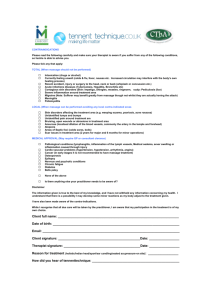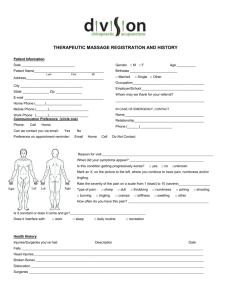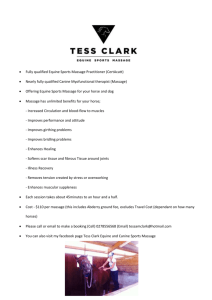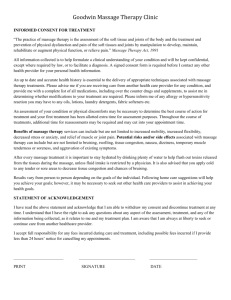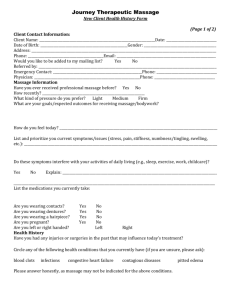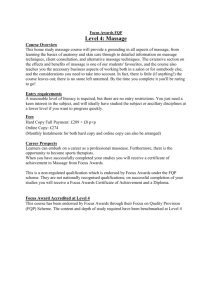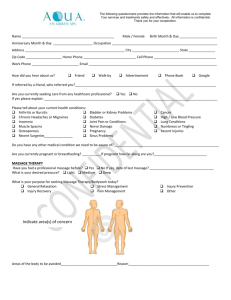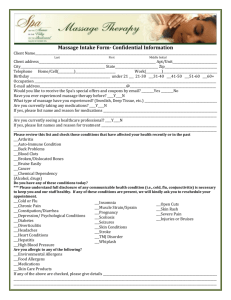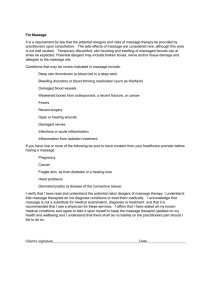Massage Sample Essay
advertisement
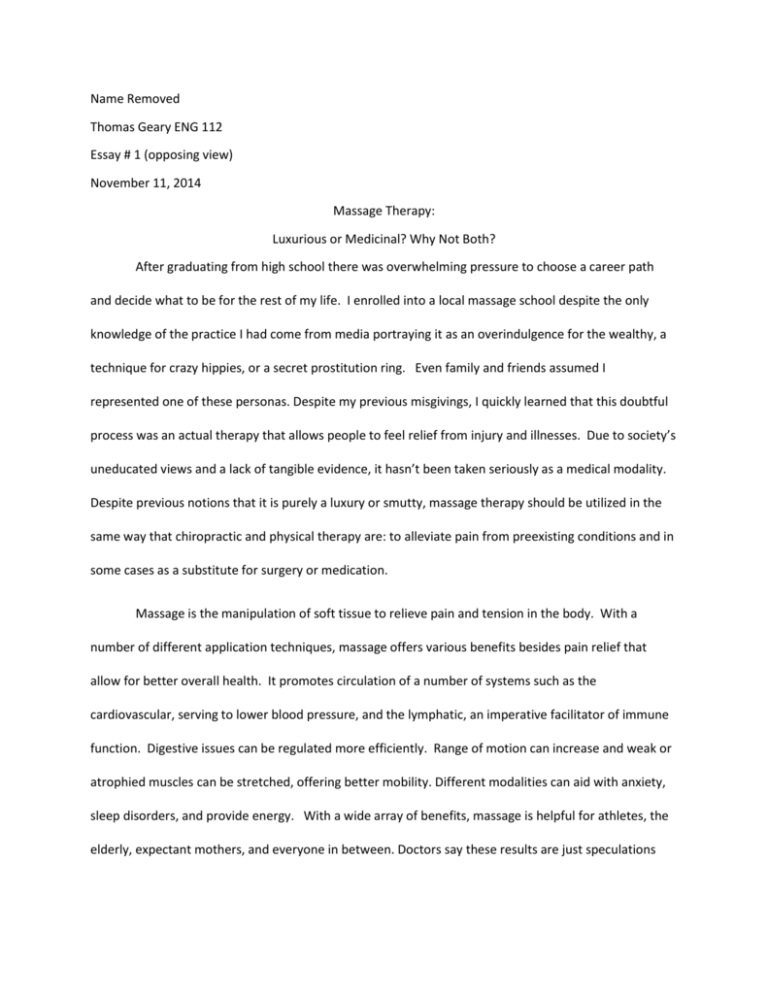
Name Removed Thomas Geary ENG 112 Essay # 1 (opposing view) November 11, 2014 Massage Therapy: Luxurious or Medicinal? Why Not Both? After graduating from high school there was overwhelming pressure to choose a career path and decide what to be for the rest of my life. I enrolled into a local massage school despite the only knowledge of the practice I had come from media portraying it as an overindulgence for the wealthy, a technique for crazy hippies, or a secret prostitution ring. Even family and friends assumed I represented one of these personas. Despite my previous misgivings, I quickly learned that this doubtful process was an actual therapy that allows people to feel relief from injury and illnesses. Due to society’s uneducated views and a lack of tangible evidence, it hasn’t been taken seriously as a medical modality. Despite previous notions that it is purely a luxury or smutty, massage therapy should be utilized in the same way that chiropractic and physical therapy are: to alleviate pain from preexisting conditions and in some cases as a substitute for surgery or medication. Massage is the manipulation of soft tissue to relieve pain and tension in the body. With a number of different application techniques, massage offers various benefits besides pain relief that allow for better overall health. It promotes circulation of a number of systems such as the cardiovascular, serving to lower blood pressure, and the lymphatic, an imperative facilitator of immune function. Digestive issues can be regulated more efficiently. Range of motion can increase and weak or atrophied muscles can be stretched, offering better mobility. Different modalities can aid with anxiety, sleep disorders, and provide energy. With a wide array of benefits, massage is helpful for athletes, the elderly, expectant mothers, and everyone in between. Doctors say these results are just speculations and that they want definitive proof, but over the past few years researchers have tried to justify that massage is relevant in the medical field. My typical client has issues with back pain, arthritis, or repetitive stress injuries (RSIs). Quite a few of them are unable to perform daily tasks, which can sometimes lead in an inability to work. Generally they turn to over the counter and prescription pain killers. Non-steroidal ant-inflammatory drugs (NSAIDs) like Aleve and Motrin are used quite often to relieve discomfort. While people undoubtedly know that these readily available medicines are not the greatest health wise, the full extent of their dangerous side effects are often ignored. Reactions such as nausea, diarrhea, dizziness, and headaches are bad enough, but more severe consequences include kidney failure, liver failure, ulcers, and the inability to clot blood (Ogbru). The American Heart Association has beseeched the medical community to find substitutes to these hazardous painkillers after they did studies that revealed surmounting evidence that NSAIDs contribute to cardiac sudden death risk and atrial fibrillation (which can lead to blood clots causing a stroke or worse) (Ogbru). Even scarier, these cardiac related risks remain a threat even after five years of discontinuing the drugs (Ogbru). So here’s the study proving NSAIDs’ fatality, but has any further interest gone into looking for an alternative? Given massage’s many benefits, it could very well be the substitute medicine needs. AMTA (American Massage Therapy Association) says, “Forty-three percent of adult Americans who had a massage between July 2012 and July 2013 received it for medical or health reasons such as pain management, soreness/stiffness/spasms, injury rehabilitation, or overall wellness, a number that did not change from 2012”, while 88% agreed it was a good pain reliever (Patrick). People who are Further research conducted by the National Center of Biotechnology Information (NCBI) revealed that patients with a number of different back pain related issues benefited from massage (Bender). The test was done by splitting a group of people in two; half to receive massage only and the other to receive massage and NSAIDs (Bender). There was no difference of pain relief in the two groups, strongly suggesting that massage can be used as an alternative to these life threatening drugs(Bender). Even with all of the positive feedback massage received as a pain reliever, there has still not been a large push to add it to modern medicine. Repetitive stress injuries (RSIs) are quite common due to an increase in computer usage over the past decade. They have caused a rise in problems like carpal tunnel syndrome (CTS), a condition in which the median nerve is pinched causing pain, tingling, and a loss in grip strength in the hand and wrist. Typically chronic CTS results in surgery but, multiple studies have revealed that massage showed improvements in grasping and a decrease in pain (Perlman, Adam). Researchers at the Journal of Bodywork and Movement Therapies suggest that patients combine daily self-care massages and weekly professional sessions for maximum results (Perlman, Adam). In massage school we had to do a certain amount of massages before we could graduate. One client in particular was a dental hygienist who had carpal tunnel syndrome (CTS) and she had to take off work a lot due to her debilitating CTS. After regular biweekly massages that lasted only a few months, she was able to go back to work, relieve her of the CTS brace, and was showing virtually no symptoms of her CTS. She was the first to exhibit the medicinal potential of massage, but I have had many clients like her since who have obtained similar results. Due to an increase in lifespan, the number of arthritis-related illnesses is also growing. In a two part study on the effectiveness of massage on Osteoarthritis (OA), a study was done at the Institute of Complementary and Alternative Medicine to identify the overall benefits of massage (Perlman, Al). The patient was randomly chosen to have either four weeks of biweekly treatments followed by four weeks of weekly treatments, or eight weeks with no treatment using only their usual care regime (Perlman, Al). The results showed a significant improvement with the help of massage that lasted up to eight weeks after treatment ended (Perlman, Al). The researchers concluded that “Given the limitations and adverse effects of pharmacologic and nonpharmacologic treatments for OA, massage therapy seems to be a viable option as an adjunct to more conventional treatment modalities”, provides professional opinion that massage should be considered a therapy, like chiropractic and physical therapy(Perlman, Al). In the second part of this study researchers attempted to calculate how many massages provided maximum benefit (Crane). 125 people were split into four groups and assigned different times to determine the proper dosage (Crane). The study resulted in no seemingly significant difference in the amount of pain between the groups at the end of eight weeks, however, the pain was reduced earlier in those that had 60 minute massages compared to those with 30 minutes (Crane). All groups excluding the one with minimal massage were able to walk faster and farther at the end of eight weeks (Crane). It was concluded that the optimal dose of massage that provided the most cost effective but still beneficial treatment was once weekly (Crane). These two experiments show evidence that massages can be used to greatly reduce pain, providing a reduction in medical necessities and other financial burdens as well as providing overall improved quality of life. Until recently, no hard evidence has been given to justify massage’s biological effects on the body, giving doubt to the medical community in regard to it’s therapeutic remedy. The scientists at the Buck Institute For Research and Aging asked male athletes to perform a vigorous workout, massaged one leg, and took biopsies of both quadriceps (8). The conclusions of the experiment were a potential increase in mitochondrial biogenesis, stimulants that are responsible for the conversion of nutrients into energy, and a reduction of inflammatory cytokines (8). The resulting lower inflammation and pain were seemingly the same to those of over-the-counter anti-inflammatory drugs(8). As inflammation is at the heart of most all injuries, including RTI and CTS, this study strongly corroborates massage’s many potential advantages. Mark Tarnopolsky, MD, PhD stated “The potential benefits of massage could be useful to a broad spectrum of individuals including the elderly, those suffering from musculoskeletal injuries, and patients with chronic inflammatory conditions” (8). Tarnopolsky also believed that massage could be used in the medical field due to its’ growing positive results(8). These studies without a doubt should be expanded upon by the health system. ABMP (American Bodywork & Massage Professionals), commissioned a report done to determine how many massages the population gets a year (Patrick). 16% of adult Americans received a massage in 2012, a number that has doubled since 2007, while 32% received at least one in their lifetime (Patrick). With all of the benefits why aren’t more people exposing themselves to this nonevasive pain reliever? Despite having been around for thousands of years, massage has gotten a bad rap for being part of brothels or massage parlors until only a few decades ago. Media has inhibited the growth of this therapeutic remedy, often depicting cringe-worthy scenes of sexual experiences involving massage in films. However, according to a survey done by ABMP they argue, “Although the massage profession is still affected by having its’ name pirated as unsavory and illegal ‘massage parlors’, the general public in 2013 is aware that legitimate, professional massage therapy is entirely non-sexual and provides many physical benefits” (Patrick). In fact they found only three percent of the population associated massage as sexual and about half connected it with healing and relaxation (Patrick). Though it’s no longer seen as so depraved, there are still a number of other issues inhibiting massage’s growth in society. Generally the public has appeared unaware of the medicinal purposes, seeing massage only as an unnecessary indulgence and should be sought solely on vacations or special occasions. Dr. Mark Hyman Rapaport of Emory University School of Medicine in Atlanta, studies the effects massage has on anxiety disorder, having a firm belief in the therapy (Majchrzyck). Prior to his research he had doubtful opinions admitting, "My wife liked massages and I wasn't quite sure why, I thought of it as an extravagance, a luxury for only people who are very rich and who pamper themselves” (Peterson). With the growth of franchises like Massage Envy and a boom in complementary and alternative medicine (CAM) in the past few years, the public has become more convinced of massage’s therapeutic results. ABMP states that seventy percent of people get massages for relaxation, but sixty-six percent seek the treatment for pain relief, and thirty percent for injury rehabilitation (the numbers add up to over one hundred due to multiple reasons by each patient) (Patrick). Word of mouth has provided an increase in massage, but there is still something that appears to be keeping a large portion of American’s from receiving them. Currently the biggest argument for patrons to avoid massage is the price. If the average massage costs $69 and the possible benefits require a minimum of once per month, the cost can add up quickly (Patrick). According to a survey done in 2013 by ABMP, 58% of American adults and 96% of massage therapist would appreciate health insurance covering the procedure (Patrick). A number of physical therapy and chiropractic clinics harbor massage therapists to work alongside them. While the two treatments are covered as a method of correcting an issue, massage is very rarely covered under health insurance. This lack in coverage can probably be attributed to massage being seen as somewhat laughable in the medical community. Hopefully this will change with the amount of readily available research offered and the influx in society’s thirst for complementary and alternative medicine (CAM). Regrettably there is a lot of friction from pharmaceutical companies that undoubtedly want to maintain their products relevance to gain money. Massage as a Though my views on massage before school were much like society’s, in that it is a simple luxury, six years as a therapist has proven otherwise. I have witnessed many people come in with very painful issues, and have assisted their body in healing itself. There is a wealth of knowledge that is accruing every year proving massage’s many benefits. Until the medical community can embrace CAM methods, massage will probably never be taken seriously. Massage needs to be treated as a modality listed under the same umbrella term as those of physical therapy and chiropractic care as an effective solution to pains, injuries, and illnesses. Works Cited Bender, Michele. “Why Massage is a Necessity, Not a Luxury.” Doctor Oz. Doctor Oz, 19 June 2014. Web. 11 Nov. 2014. Crane, Justin D.; Ogborn, Daniel I.; Cupido, Colleen; Melov, Simon; Hubbard, Alan; Bourgeois, Jacqueline M.; Tarnopolsky, Mark A. “Massage Therapy Attnuates Inflammatory Signlaing After ExerciseInduced Muscle Damage.” Science Translational Medicine Volume 4. Issue 119 (2012): page 119ra13. Web. Majchrzyck, M; Kocur, P; Kotwicki, T. “Deep Tissue Massage and Nonsteroidal Anti-inflammatory Drugs For Low Back Pain: A Prospective Randomized Trial.” Scientific World Journal. PubMed, 23 Feb 2014. Web. 11 Nov. 2014. Ogbru, Omudhome. “Nonsteroidal Anti-inflammatory Drugs (NSAIDs).” MedicineNet, 22 Oct.2013. Web. 11 Nov. 2014. Patrick, Carrie. “Massage Profession Metrics.” Massage Therapy. ABMP, n.d. Web. 11 Nov. 2014. Peterson, Andrea. “Don’t Call it Pampering: Massage Wants to Be Medicine.” WSJ. The Wall Street Journal, 13 March, 2012. Web. 11 Nov. 2014. Perlman, Adam; MPH; Alyse, Sabrina; Williams, Anna-Leila; Njike, VY; Katz, David L. “Massage Therapy for Osteoarthritis of the Knee: A Randomized Controlled Trial.” JAMA Internal Medicine. Arch Intern Med, 2006. Web. 04 November 2014. Perlman, Al; Ali, A; Njike, Vy; Hom, D; Davidi, A; Gould-Fogerite, S; Milak, C; Katz, Dl. “Massage Therapy for Osteoarthritis of the Knee: A Randomized Dose-finding Trial.” Plos One. N.p., 08 February 2012. Web. 04 November 2014.

